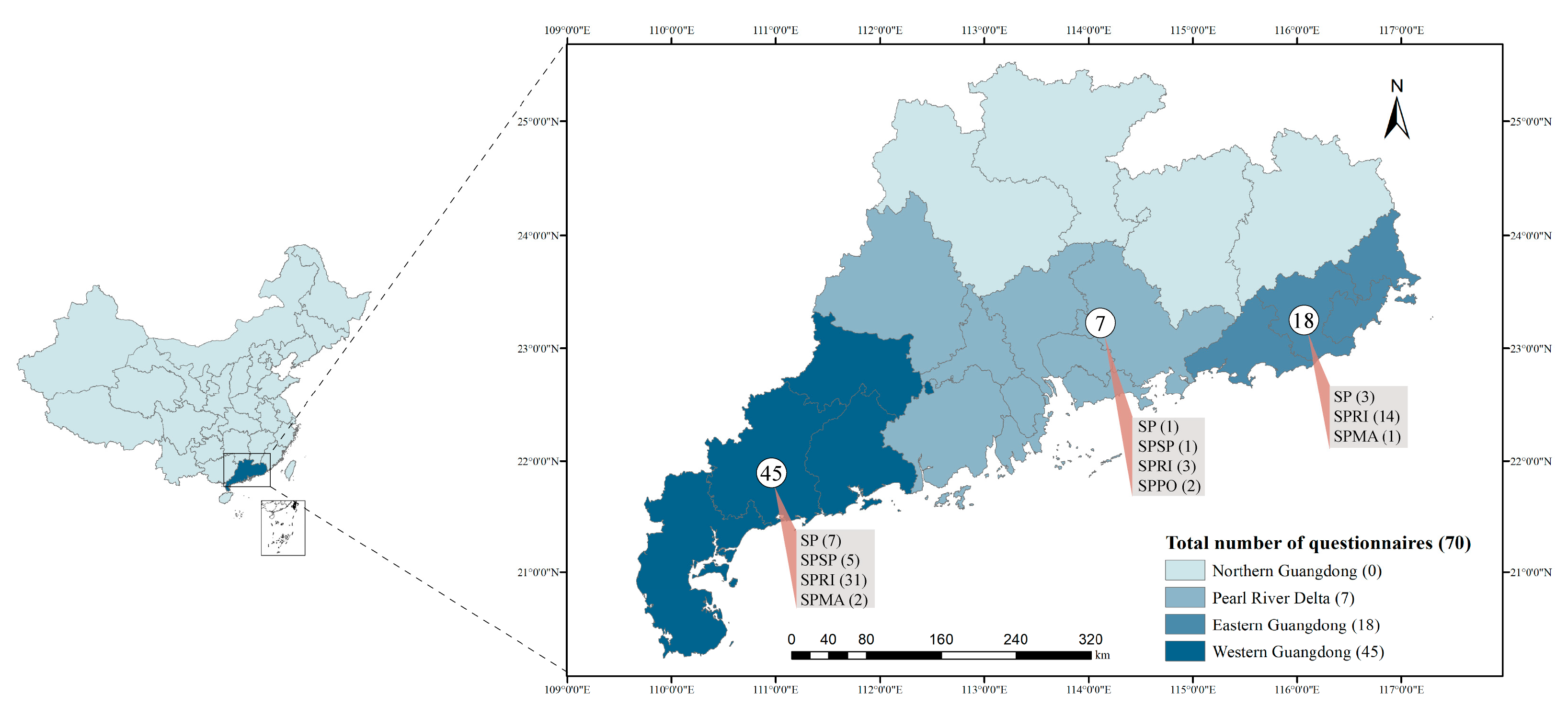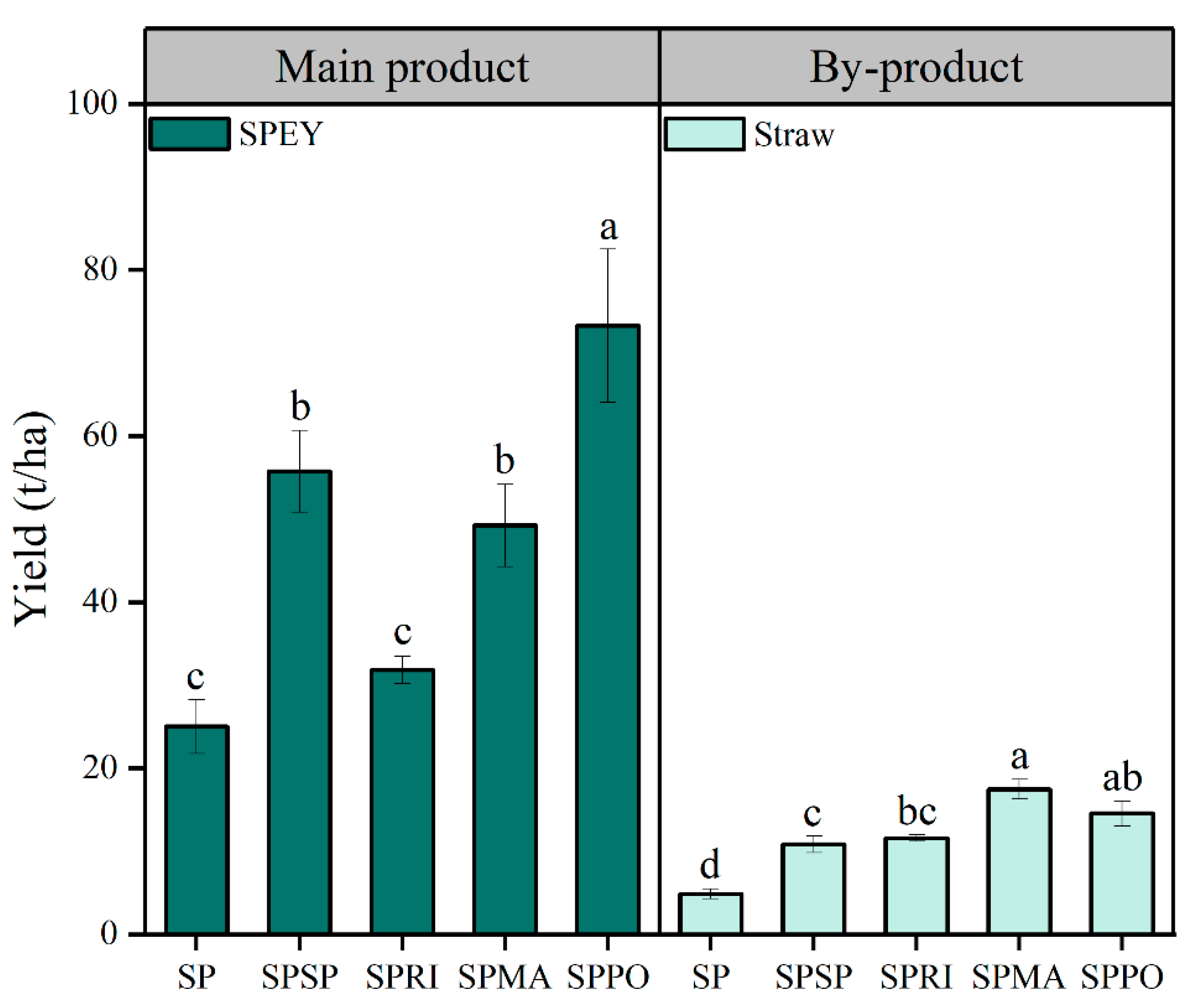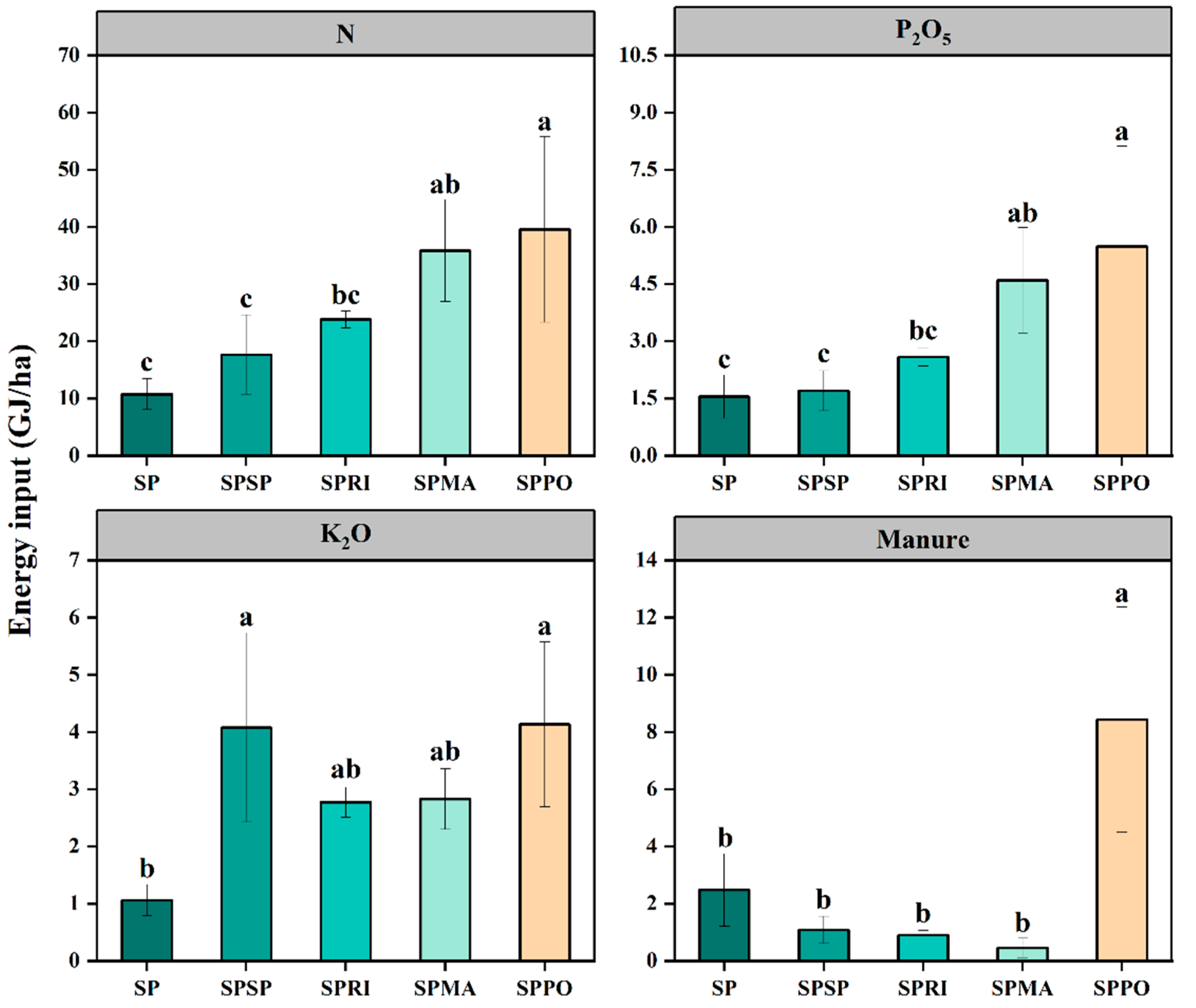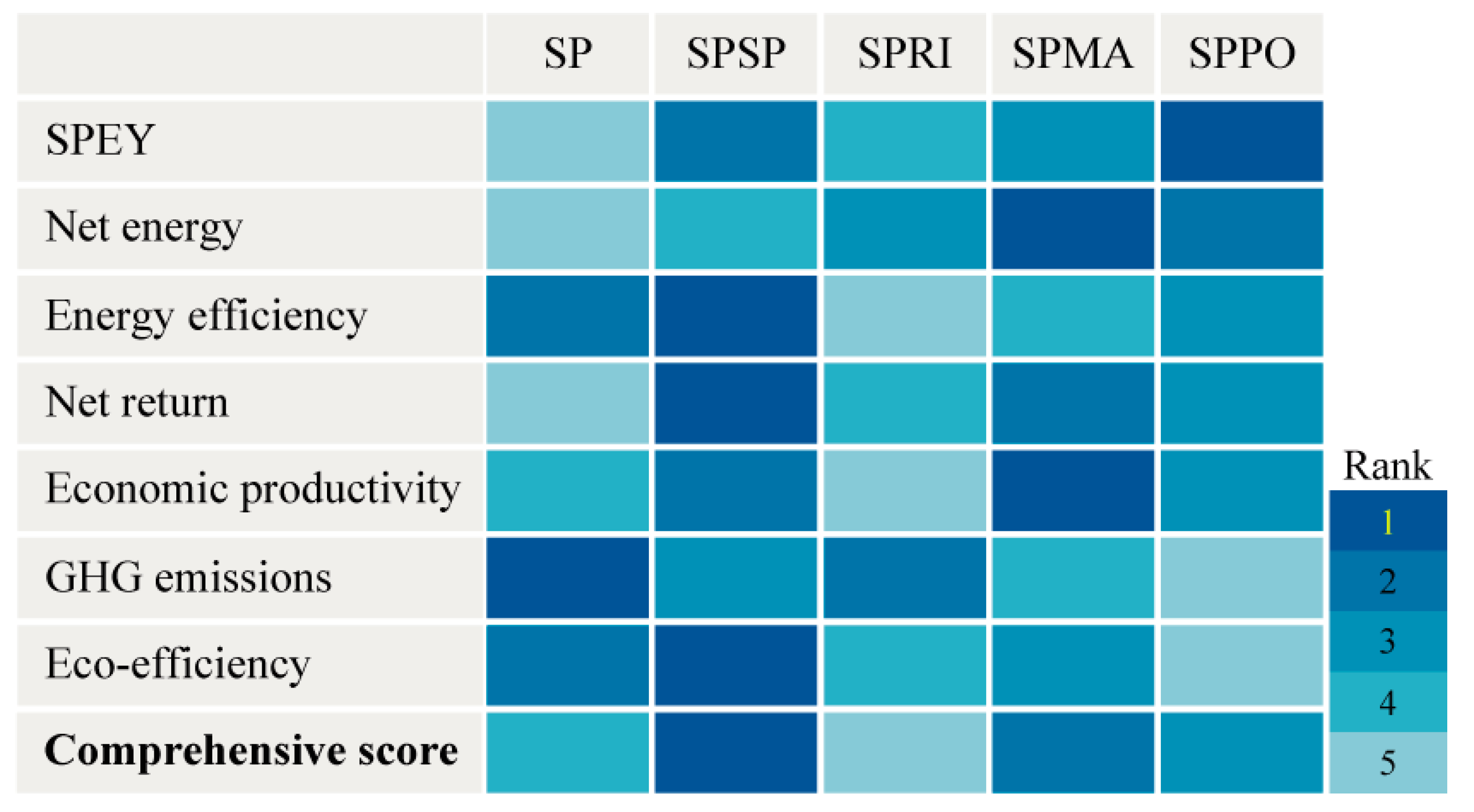Life-Cycle Energy, Economic, and Greenhouse Gas Emissions of Diversified Sweet-Potato-Based Cropping Systems in South China
Abstract
1. Introduction
2. Materials and Methods
2.1. Survey Sites and Data Collection
2.2. Yield Calculation
2.3. Life-Cycle Energy Performance
2.4. Life-Cycle Economic Performance
2.5. Life-Cycle GHG Emissions
2.6. Eco-Efficiency
2.7. Statistical Analysis
3. Results
3.1. Input and Output
3.2. Energy Performance
3.3. Economic Analysis
3.4. GHG Emissions and Eco-Efficiency
3.5. Comprehensive Assessment
4. Discussion
4.1. Energy and Environmental Performance of Sweet-Potato-Based Cropping Systems
4.2. Economic Perspective of Sweet-Potato-Based Cropping Systems
4.3. Candidate Cropping Systems for Sweet-Potato Production
5. Conclusions
Supplementary Materials
Author Contributions
Funding
Institutional Review Board Statement
Informed Consent Statement
Data Availability Statement
Acknowledgments
Conflicts of Interest
References
- Antar, M.; Lyu, D.; Nazari, M.; Shah, A.; Zhou, X.; Smith, D.L. Biomass for a sustainable bioeconomy: An overview of world biomass production and utilization. Renew. Sustain. Energy Rev. 2021, 139, 110691. [Google Scholar] [CrossRef]
- Deng, J.; Ni, H.; Zhang, Z.; Usman, S.; Yang, X.; Shen, Y.; Li, Y. Designing productive, energy-efficient, and environmentally friendly production systems by replacing fallow period with annual forage cultivation on the Loess Plateau of China. J. Clean. Prod. 2021, 320, 128660. [Google Scholar] [CrossRef]
- Gan, Y.; Liang, C.; Chai, Q.; Lemke, R.L.; Campbell, C.A.; Zentner, R.P. Improving farming practices reduces the carbon footprint of spring wheat production. Nat. Commun. 2014, 5, 5012. [Google Scholar] [CrossRef]
- Yang, Y.; Reilly, E.C.; Jungers, J.M.; Chen, J.; Smith, T.M. Climate Benefits of Increasing Plant Diversity in Perennial Bioenergy Crops. One Earth 2019, 1, 434–445. [Google Scholar] [CrossRef]
- Zegada-Lizarazu, W.; Monti, A. Energy crops in rotation. A review. Biomass Bioenergy 2011, 35, 12–25. [Google Scholar] [CrossRef]
- Zhang, K.; Maltais-Landry, G.; Liao, H.-L. How soil biota regulate C cycling and soil C pools in diversified crop rotations. Soil Biol. Biochem. 2021, 156, 108219. [Google Scholar] [CrossRef]
- Gao, J.; Yang, X.; Zheng, B.; Liu, Z.; Zhao, J.; Sun, S.; Li, K.; Dong, C. Effects of climate change on the extension of the potential double cropping region and crop water requirements in Northern China. Agric. For. Meteorol. 2019, 268, 146–155. [Google Scholar] [CrossRef]
- Yang, X.; Chen, F.; Lin, X.; Liu, Z.; Zhang, H.; Zhao, J.; Li, K.; Ye, Q.; Li, Y.; Lv, S.; et al. Potential benefits of climate change for crop productivity in China. Agric. For. Meteorol. 2015, 208, 76–84. [Google Scholar] [CrossRef]
- FAOSTAT (Statistics division of Food and Agriculture Organization of the United Nations). 2020. Available online: http://www.fao.org/faostat/zh/#data/QC (accessed on 5 January 2021).
- Wang, S.; Yang, L.; Su, M.; Ma, X.; Sun, Y.; Yang, M.; Zhao, P.; Shen, J.; Zhang, F.; Goulding, K.; et al. Increasing the agricultural, environmental and economic benefits of farming based on suitable crop rotations and optimum fertilizer applications. Field Crop. Res. 2019, 240, 78–85. [Google Scholar] [CrossRef]
- Cui, J.; Yan, P.; Wang, X.; Yang, J.; Li, Z.; Yang, X.; Sui, P.; Chen, Y. Integrated assessment of economic and environmental consequences of shifting cropping system from wheat-maize to monocropped maize in the North China Plain. J. Clean. Prod. 2018, 193, 524–532. [Google Scholar] [CrossRef]
- D’Amato, D.; Droste, N.; Allen, B.; Kettunen, M.; Lähtinen, K.; Korhonen, J.; Leskinen, P.; Matthies, B.D.; Toppinen, A. Green, circular, bio economy: A comparative analysis of sustainability avenues. J. Clean. Prod. 2017, 168, 716–734. [Google Scholar] [CrossRef]
- Htwe, T.; Sinutok, S.; Chotikarn, P.; Amin, N.; Akhtaruzzaman, M.; Techato, K.; Hossain, T. Energy use efficiency and cost-benefits analysis of rice cultivation: A study on conventional and alternative methods in Myanmar. Energy 2020, 214, 119104. [Google Scholar] [CrossRef]
- Stolarski, M.J.; Krzyżaniak, M.; Tworkowski, J.; Załuski, D.; Kwiatkowski, J.; Szczukowski, S. Camelina and crambe production—Energy efficiency indices depending on nitrogen fertilizer application. Ind. Crops Prod. 2019, 137, 386–395. [Google Scholar] [CrossRef]
- Zhang, W.; Qian, C.; Carlson, K.M.; Ge, X.; Wang, X.; Chen, X. Increasing farm size to improve energy use efficiency and sustainability in maize production. Food Energy Secur. 2021, 10, e271. [Google Scholar] [CrossRef]
- Fang, Y.R.; Liu, J.A.; Steinberger, Y.; Xie, G.H. Energy use efficiency and economic feasibility of Jerusalem artichoke production on arid and coastal saline lands. Ind. Crops Prod. 2018, 117, 131–139. [Google Scholar] [CrossRef]
- Li, S.; Wu, J.; Wang, X.; Ma, L. Economic and environmental sustainability of maize-wheat rotation production when substituting mineral fertilizers with manure in the North China Plain. J. Clean. Prod. 2020, 271, 122683. [Google Scholar] [CrossRef]
- Huang, W.; Wu, F.; Han, W.; Li, Q.; Han, Y.; Wang, G.; Feng, L.; Li, X.; Yang, B.; Lei, Y.; et al. Carbon footprint of cotton production in China: Composition, spatiotemporal changes and driving factors. Sci. Total Environ. 2022, 821, 153407. [Google Scholar] [CrossRef]
- Chen, X.; Xu, X.; Lu, Z.; Zhang, W.; Yang, J.; Hou, Y.; Wang, X.; Zhou, S.; Li, Y.; Wu, L.; et al. Carbon footprint of a typical pomelo production region in China based on farm survey data. J. Clean. Prod. 2020, 277, 124041. [Google Scholar] [CrossRef]
- Hosseinzadeh-Bandbafha, H.; Nabavi-Pelesaraei, A.; Khanali, M.; Ghahderijani, M.; Chau, K.-W. Application of data envelopment analysis approach for optimization of energy use and reduction of greenhouse gas emission in peanut production of Iran. J. Clean. Prod. 2018, 172, 1327–1335. [Google Scholar] [CrossRef]
- Yang, X.; Gao, W.; Zhang, M.; Chen, Y.; Sui, P. Reducing agricultural carbon footprint through diversified crop rotation systems in the North China Plain. J. Clean. Prod. 2014, 76, 131–139. [Google Scholar] [CrossRef]
- Jankowski, K.J.; Dubis, B.; Sokólski, M.M.; Załuski, D.; Bórawski, P.; Szempliński, W. Productivity and energy balance of maize and sorghum grown for biogas in a large-area farm in Poland: An 11-year field experiment. Ind. Crops Prod. 2020, 148, 112326. [Google Scholar] [CrossRef]
- Xiong, L.; Liang, C.; Ma, B.; Shah, F.; Wu, W. Carbon footprint and yield performance assessment under plastic film mulching for winter wheat production. J. Clean. Prod. 2020, 270, 122468. [Google Scholar] [CrossRef]
- Komleh, S.H.P.; Ghahderijani, M.; Sefeedpari, P. Energy consumption and CO2 emissions analysis of potato production based on different farm size levels in Iran. J. Clean. Prod. 2012, 33, 183–191. [Google Scholar] [CrossRef]
- Liu, H.; Ren, L.; Spiertz, H.; Zhu, Y.; Xie, G.H. An economic analysis of sweet sorghum cultivation for ethanol production in North China. GCB Bioenergy 2014, 7, 1176–1184. [Google Scholar] [CrossRef]
- Tang, C.; Lu, Y.; Jiang, B.; Chen, J.; Mo, X.; Yang, Y.; Wang, Z. Energy, Economic, and Environmental Assessment of Sweet Potato Production on Plantations of Various Sizes in South China. Agronomy 2022, 12, 1290. [Google Scholar] [CrossRef]
- Soni, P.; Sinha, R.; Perret, S.R. Energy use and efficiency in selected rice-based cropping systems of the Middle-Indo Gangetic Plains in India. Energy Rep. 2018, 4, 554–564. [Google Scholar] [CrossRef]
- Yang, X.; Sun, B.; Gao, W.; Chen, Y.; Sui, P. Carbon footprints of grain-, forage-, and energy-based cropping systems in the North China plain. Int. J. Life Cycle Assess. 2018, 24, 371–385. [Google Scholar] [CrossRef]
- Li, S.; Wu, J.; Ma, L. Economic, energy and environmental consequences of shifting from maize-wheat to forage rotation in the North China Plain. J. Clean. Prod. 2021, 328, 129670. [Google Scholar] [CrossRef]
- National Bureau of Statistics, China. Available online: https://data.stats.gov.cn (accessed on 20 May 2021).
- Liu, K.; Blackshaw, R.E.; Johnson, E.N.; Hossain, Z.; Hamel, C.; St-Arnaud, M.; Gan, Y. Lentil enhances the productivity and stability of oilseed-cereal cropping systems across different environments. Eur. J. Agron. 2019, 105, 24–31. [Google Scholar] [CrossRef]
- Fang, Y.R.; Wu, Y.; Xie, G.H. Crop residue utilizations and potential for bioethanol production in China. Renew. Sustain. Energy Rev. 2019, 113, 109288. [Google Scholar] [CrossRef]
- Wang, X.; Chen, Y.; Sui, P.; Yan, P.; Yang, X.; Gao, W. Preliminary analysis on economic and environmental consequences of grain production on different farm sizes in North China Plain. Agric. Syst. 2017, 153, 181–189. [Google Scholar] [CrossRef]
- CLCD 0.8, Chinese Core Life Cycle Database. Integrated Knowledge for our Environment, Chengdu, China. Available online: http://www.ike-global.com (accessed on 15 May 2021).
- Tian, X.; Wu, Y.; Hou, P.; Liang, S.; Qu, S.; Xu, M.; Zuo, T. Environmental impact and economic assessment of secondary lead production: Comparison of main spent lead-acid battery recycling processes in China. J. Clean. Prod. 2017, 144, 142–148. [Google Scholar] [CrossRef]
- Yang, Y.; Ni, J.-Q.; Zhou, S.; Xie, G.H. Comparison of energy performance and environmental impacts of three corn stover-based bioenergy pathways. J. Clean. Prod. 2020, 272, 122631. [Google Scholar] [CrossRef]
- Meng, Q.; Wang, H.; Yan, P.; Pan, J.; Lu, D.; Cui, Z.; Zhang, F.; Chen, X. Designing a new cropping system for high productivity and sustainable water usage under climate change. Sci. Rep. 2017, 7, srep41587. [Google Scholar] [CrossRef] [PubMed]
- Gao, B.; Ju, X.; Meng, Q.; Cui, Z.; Christie, P.; Chen, X.; Zhang, F. The impact of alternative cropping systems on global warming potential, grain yield and groundwater use. Agric. Ecosyst. Environ. 2015, 203, 46–54. [Google Scholar] [CrossRef]
- Dubis, B.; Jankowski, K.J.; Sokólski, M.M.; Załuski, D.; Bórawski, P.; Szempliński, W. Biomass yield and energy balance of fodder galega in different production technologies: An 11-year field experiment in a large-area farm in Poland. Renew. Energy 2020, 154, 813–825. [Google Scholar] [CrossRef]
- Stolarski, M.J.; Krzyżaniak, M.; Kwiatkowski, J.; Tworkowski, J.; Szczukowski, S. Energy and economic efficiency of camelina and crambe biomass production on a large-scale farm in north-eastern Poland. Energy 2018, 150, 770–780. [Google Scholar] [CrossRef]
- Cui, Z.; Zhang, H.; Chen, X.; Zhang, C.; Ma, W.; Huang, C.; Zhang, W.; Mi, G.; Miao, Y.; Li, X.; et al. Pursuing sustainable productivity with millions of smallholder farmers. Nature 2018, 555, 363–366. [Google Scholar] [CrossRef]
- Wu, Y.; Xi, X.; Tang, X.; Luo, D.; Gu, B.; Lam, S.K.; Vitousek, P.M.; Chen, D. Policy distortions, farm size, and the overuse of agricultural chemicals in China. Proc. Natl. Acad. Sci. USA 2018, 115, 7010–7015. [Google Scholar] [CrossRef]
- Ju, X.-T.; Xing, G.-X.; Chen, X.-P.; Zhang, S.-L.; Zhang, L.-J.; Liu, X.-J.; Cui, Z.-L.; Yin, B.; Christie, P.; Zhu, Z.-L.; et al. Reducing environmental risk by improving N management in intensive Chinese agricultural systems. Proc. Natl. Acad. Sci. USA 2009, 106, 3041–3046. [Google Scholar] [CrossRef]
- Xu, R.; Tian, H.; Pan, S.; Prior, S.A.; Feng, Y.; Batchelor, W.D.; Chen, J.; Yang, J. Global ammonia emissions from synthetic nitrogen fertilizer applications in agricultural systems: Empirical and process-based estimates and uncertainty. Glob. Chang. Biol. 2019, 25, 314–326. [Google Scholar] [CrossRef]
- Zhang, Y.; Wang, H.; Lei, Q.; Luo, J.; Lindsey, S.; Zhang, J.; Zhai, L.; Wu, S.; Zhang, J.; Liu, X.; et al. Optimizing the nitrogen application rate for maize and wheat based on yield and environment on the Northern China Plain. Sci. Total Environ. 2017, 618, 1173–1183. [Google Scholar] [CrossRef]
- Mandal, K.; Saha, K.; Ghosh, P.; Hati, K.; Bandyopadhyay, K. Bioenergy and economic analysis of soybean-based crop production systems in central India. Biomass-Bioenergy 2002, 23, 337–345. [Google Scholar] [CrossRef]
- Chen, X.; Cui, Z.; Fan, M.; Vitousek, P.; Zhao, M.; Ma, W.; Wang, Z.; Zhang, W.; Yan, X.; Yang, J.; et al. Producing more grain with lower environmental costs. Nature 2014, 514, 486–489. [Google Scholar] [CrossRef] [PubMed]
- Wang, J.; Zhang, L.; He, X.; Zhang, Y.; Wan, Y.; Duan, S.; Xu, C.; Mao, X.; Chen, X.; Shi, X. Environmental mitigation potential by improved nutrient managements in pear (Pyrus pyrifolia L.) orchards based on life cycle assessment: A case study in the North China Plain. J. Clean. Prod. 2020, 262, 121273. [Google Scholar] [CrossRef]
- Wang, Y.Y.; Cheng, Y.H.; Chen, K.E.; Tsay, Y.F. Nitrate Transport, Signaling, and Use Efficiency. Annu. Rev. Plant Biol. 2018, 69, 85–122. [Google Scholar] [CrossRef]
- Cai, S.; Pittelkow, C.M.; Zhao, X.; Wang, S. Winter legume-rice rotations can reduce nitrogen pollution and carbon footprint while maintaining net ecosystem economic benefits. J. Clean. Prod. 2018, 195, 289–300. [Google Scholar] [CrossRef]
- Muazu, A.; Yahya, A.; Ishak, W.; Bejo, S.K. Machinery utilization and production cost of paddy cultivation under wetland direct seeding conditions in Malaysia. Eng. Agric. Environ. Food 2015, 8, 289–297. [Google Scholar] [CrossRef]
- Gao, Z.; Han, M.; Hu, Y.; Li, Z.; Liu, C.; Wang, X.; Tian, Q.; Jiao, W.; Hu, J.; Liu, L.; et al. Effects of Continuous Cropping of Sweet Potato on the Fungal Community Structure in Rhizospheric Soil. Front. Microbiol. 2019, 10, 2269. [Google Scholar] [CrossRef]
- Zhao, J.; Yang, Y.; Zhang, K.; Jeong, J.; Zeng, Z.; Zang, H. Does crop rotation yield more in China? A meta-analysis. Field Crops Res. 2019, 245, 107659. [Google Scholar] [CrossRef]
- Munkholm, L.J.; Heck, R.J.; Deen, B. Long-term rotation and tillage effects on soil structure and crop yield. Soil Tillage Res. 2013, 127, 85–91. [Google Scholar] [CrossRef]
- Bennett, A.J.; Bending, G.; Chandler, D.; Hilton, S.; Mills, P. Meeting the demand for crop production: The challenge of yield decline in crops grown in short rotations. Biol. Rev. 2011, 87, 52–71. [Google Scholar] [CrossRef] [PubMed]
- Winter, M.; de Mol, F.; von Tiedemann, A. Cropping systems with maize and oilseed rape for energy production may reduce the risk of stem base diseases in wheat. Field Crops Res. 2014, 156, 249–257. [Google Scholar] [CrossRef]
- Qin, S.; Yeboah, S.; Cao, L.; Zhang, J.; Shi, S.; Liu, Y. Breaking continuous potato cropping with legumes improves soil microbial communities, enzyme activities and tuber yield. PLoS ONE 2017, 12, e0175934. [Google Scholar] [CrossRef]






| Cropping System | Western Guangdong | Eastern Guangdong | Pearl River Delta |
|---|---|---|---|
| Longitude | 109°48′−112°18′ | 115°36′−116°63′ | 113°09′−114°55′ |
| Latitude | 20°31′−22°12′ | 22°53′−23°66′ | 22°49′−23°08′ |
| Soil pH a | 5.4 ± 0.7 | 5.5 ± 0.6 | 5.2 ± 0.3 |
| Soil organic matter (g/kg) a | 15.2 ± 6.5 | 16.9 ± 8.9 | 21.0 ± 3.7 |
| Total nitrogen (g/kg) a | 1.0 ± 0.4 | 1.1 ± 0.5 | 1.4 ± 0.2 |
| Available phosphorus (mg/kg) a | 118.2 ± 112.0 | 54.1 ± 42.3 | 342.7 ± 78.3 |
| Available potassium (mg/kg) a | 80.2 ± 54.8 | 89.3 ± 42.1 | 80.8 ± 48.4 |
| Mean annual temperature (°C) b | 23.6 ± 0.4 | 22.8 ± 0.6 | 21.8 ± 0.1 |
| Precipitation (mm) b | 2012.7 ± 658.2 | 1470.7 ± 208.6 | 1525.8 ± 222.5 |
| Parameter | Unit | SP | SPSP | SPRI | SPMA | SPPO |
|---|---|---|---|---|---|---|
| (n = 11) | (n = 6) | (n = 48) | (n =3) | (n = 2) | ||
| Input | ||||||
| 1-Land rent | CNY/ha | 5291 | 5950 | 3831 | 5250 | 14,250 |
| 2-Labor | h/ha | 738 | 1567 | 1285 | 1269 | 1738 |
| 3-Machinery | h/ha | 10 | 20 | 14 | 13 | 14 |
| 4-Diesel fuel | L/ha | 144 | 285 | 198 | 187 | 199 |
| 5-Fertilizers | ||||||
| Nitrogen (N) | kg/ha | 117 | 192 | 259 | 389 | 430 |
| Phosphorus (P2O5) | kg/ha | 115 | 127 | 195 | 343 | 410 |
| Potassium (K2O) | kg/ha | 116 | 444 | 300 | 307 | 449 |
| Farmyard manure | kg/ha | 8268 | 3600 | 3050 | 1500 | 28,125 |
| 6-Pesticides | ||||||
| Herbicides | kg/ha | 3.06 | 8.27 | 2.41 | 0.87 | 21.53 |
| Insecticides | kg/ha | 0.18 | 0.27 | 0.36 | 0.73 | 1.18 |
| Fungicides | kg/ha | 0.40 | 1.00 | 0.56 | 0.80 | 2.14 |
| 7-Water for irrigation | m3/ha | 34 | 121 | 20 | 50 | 0 |
| 8-Plastic film | kg/ha | 11 | 45 | 18 | 180 | 300 |
| 9-Seed | kg/ha | 2092 | 4259 | 1895/26(RI) | 1821/25(MA) | 1533/2250(PO) |
| Output | ||||||
| Crop yield | t/ha | 25.02 | 55.75 | 25.31/6.65(RI) | 35.00/11.98(MA) | 33.75/41.25(PO) |
| Parameter | SP | SPSP | SPRI | SPMA | SPPO | ANOVA |
|---|---|---|---|---|---|---|
| (n = 11) | (n = 6) | (n = 48) | (n =3) | (n = 2) | ||
| Input (MJ/ha) | 33,646 | 61,950 | 51,811 | 73,701 | 105,961 | *** |
| Labor | 1446 | 3071 | 2531 | 2487 | 3406 | * |
| Machinery | 2142 | 4244 | 2969 | 2777 | 2959 | * |
| Diesel fuel | 5258 | 10,417 | 7287 | 6817 | 7264 | * |
| Fertilizers | 15,853 | 24,538 | 30,087 | 43,720 | 57,607 | *** |
| Pesticides | 814 | 1888 | 767 | 611 | 5525 | *** |
| Water for irrigation | 34 | 124 | 17 | 51 | 0 | ** |
| Plastic film | 567 | 2337 | 941 | 9347 | 15,579 | *** |
| Seed | 7532 | 15,332 | 7213 | 7891 | 13,620 | *** |
| Output (MJ/ha) | 158,570 | 353,291 | 351,422 | 572,789 | 475,279 | *** |
| Main product | 90,082 | 200,700 | 188,283 | 323,947 | 270,000 | *** |
| By-product | 68,488 | 152,591 | 163,139 | 248,842 | 205,279 | *** |
| Net energy (MJ/ha) | 124,924 | 291,341 | 299,611 | 499,088 | 369,318 | *** |
| Energy rate | 4.71 | 5.70 | 6.78 | 7.77 | 4.49 | ** |
| Energy efficiency (kg/MJ) | 0.77 | 0.90 | 0.61 | 0.67 | 0.69 | * |
| Parameter | SP | SPSP | SPRI | SPMA | SPPO | ANOVA |
|---|---|---|---|---|---|---|
| (n = 11) | (n = 6) | (n = 48) | (n =3) | (n = 2) | ||
| Input (CNY/ha) | 33,818 | 63,666 | 45,843 | 55,465 | 95,100 | *** |
| Land rent | 5291 | 5950 | 3831 | 5250 | 14,250 | * |
| Labor | 11,246 | 26,470 | 21,277 | 20,560 | 32,588 | * |
| Machinery | 2396 | 6502 | 4426 | 4335 | 4582 | * |
| Diesel fuel | 918 | 1818 | 1272 | 1190 | 1268 | * |
| Fertilizers | 8935 | 13,060 | 9197 | 13,375 | 23,445 | ** |
| Pesticides | 1391 | 2625 | 2226 | 4520 | 9292 | *** |
| Water for irrigation | 94 | 340 | 47 | 140 | 0 | ** |
| Plastic film | 109 | 450 | 216 | 1800 | 3000 | *** |
| Seed | 3439 | 6451 | 3351 | 4295 | 6675 | ** |
| Output (CNY/ha) | 92,673 | 203,950 | 106,043 | 144,515 | 169,500 | *** |
| Net return(CNY/ha) | 58,855 | 140,284 | 60,200 | 89,050 | 74,400 | ** |
| Benefit to cost ratio | 2.74 | 3.20 | 2.31 | 2.61 | 1.78 | ns |
| Economic productivity (kg/CNY) | 0.74 | 0.88 | 0.69 | 0.89 | 0.77 | ns |
| Parameter | SP | SPSP | SPRI | SPMA | SPPO | ANOVA |
|---|---|---|---|---|---|---|
| (n = 11) | (n = 6) | (n = 48) | (n =3) | (n = 2) | ||
| Direct emissions a (kg CO2-eq/ha) | 436 | 715 | 964 | 1450 | 1601 | ** |
| Indirect emissions (kg CO2-eq/ha) | 1244 | 2420 | 1815 | 2302 | 3245 | *** |
| Machinery | 152 | 301 | 211 | 197 | 210 | * |
| Diesel fuel | 89 | 177 | 124 | 116 | 123 | * |
| Fertilizers | 446 | 783 | 918 | 1375 | 1632 | *** |
| Pesticides | 22 | 57 | 19 | 12 | 150 | *** |
| Plastic film | 6 | 26 | 11 | 105 | 175 | *** |
| Seed | 528 | 1075 | 532 | 497 | 955 | *** |
| Total emissions (kg CO2-eq/ha) | 1680 | 3135 | 2779 | 3752 | 4846 | *** |
| Eco-efficiency (CNY/kg CO2-eq) | 35 | 45 | 22 | 24 | 15 | * |
Publisher’s Note: MDPI stays neutral with regard to jurisdictional claims in published maps and institutional affiliations. |
© 2022 by the authors. Licensee MDPI, Basel, Switzerland. This article is an open access article distributed under the terms and conditions of the Creative Commons Attribution (CC BY) license (https://creativecommons.org/licenses/by/4.0/).
Share and Cite
Tang, C.; Jiang, B.; Ameen, A.; Mo, X.; Yang, Y.; Wang, Z. Life-Cycle Energy, Economic, and Greenhouse Gas Emissions of Diversified Sweet-Potato-Based Cropping Systems in South China. Agronomy 2022, 12, 2340. https://doi.org/10.3390/agronomy12102340
Tang C, Jiang B, Ameen A, Mo X, Yang Y, Wang Z. Life-Cycle Energy, Economic, and Greenhouse Gas Emissions of Diversified Sweet-Potato-Based Cropping Systems in South China. Agronomy. 2022; 12(10):2340. https://doi.org/10.3390/agronomy12102340
Chicago/Turabian StyleTang, Chaochen, Bingzhi Jiang, Asif Ameen, Xueying Mo, Yang Yang, and Zhangying Wang. 2022. "Life-Cycle Energy, Economic, and Greenhouse Gas Emissions of Diversified Sweet-Potato-Based Cropping Systems in South China" Agronomy 12, no. 10: 2340. https://doi.org/10.3390/agronomy12102340
APA StyleTang, C., Jiang, B., Ameen, A., Mo, X., Yang, Y., & Wang, Z. (2022). Life-Cycle Energy, Economic, and Greenhouse Gas Emissions of Diversified Sweet-Potato-Based Cropping Systems in South China. Agronomy, 12(10), 2340. https://doi.org/10.3390/agronomy12102340






